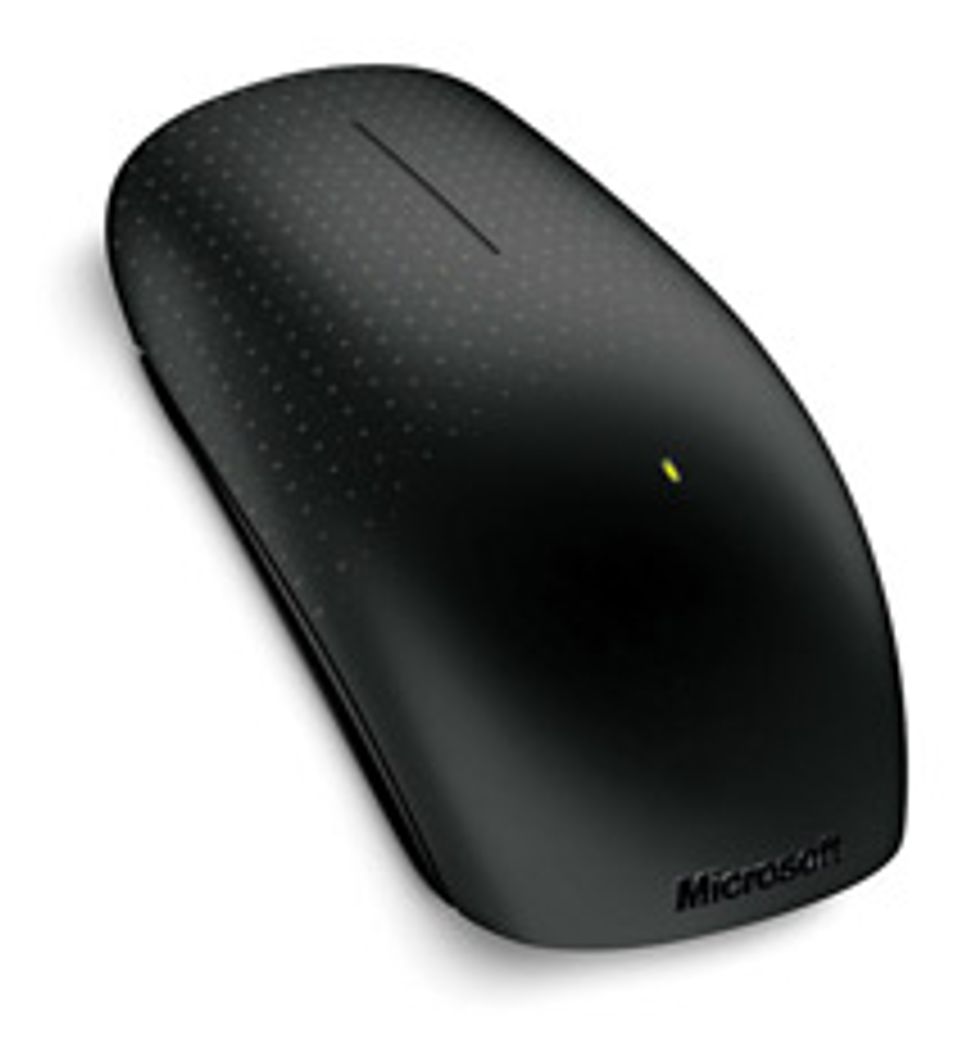There's no denying the evolution of electronic Muridae—computer mice, that is. Through the years we've seen third buttons, scroll wheels, Bluetooth wirelessness, foldability, and most recently, mice that have been turned into mobile track pads, with touch-sensitive surfaces. Apple started this latest mutation with the Magic Mouse, a sleek platform that enhances the appearance of any workstation, if not its functionality. With a hearty "challenge accepted," Microsoft created the Touch Mouse.
The Touch Mouse emulates the Magic Mouse's ability to capture gestures, not just clicks, while feeling much nicer in the hand. Microsoft, to its credit, never values aesthetics so highly as to impair function or comfort, which distinguishes its products from every mouse ever to emerge from Cupertino. And despite that commitment to function over form, Microsoft has created a graceful black teardrop of a mouse. Gridded on the front half to indicate the location of the tiny sensors that turn multitouch gestures into cursor actions, the Touch Mouse feels solid, and it glides nicely across any surface. Microsoft's BlueTrack technology lets it track more accurately than any other optical mouse I've used.
The Touch Mouse's packaging clearly says it's exclusively for Microsoft Windows 7. So the first thing I did was take the 2.4-gigahertz wireless nubbin of a transmitter out from the mouse's underbelly, where it is easily stored, and plugged it into my MacBook Air's USB socket. It worked right away as a simple two-button mouse—although it has no buttons, a subtle ridge down the middle distinguishes left from right. The real test came with my office workstation, a Dell. Inserting the transmitter brought up a driver installation dialogue in Windows 7, which quickly enabled the mouse's full potential.
Sweeping a single finger across the Touch Mouse scrolls the active window in the appropriate direction. Moving two fingers up or down maximizes or minimizes the active window, while going left or right snaps the window to the appropriate half of the screen. An upward sweep of three fingers shows all open windows; a downward sweep shows the desktop. And there are other shortcut gestures as well.
It's all very nice, if you want to manipulate windows. But I have work to do, and that's where the Touch Mouse, like most mice these days, failed me. For a decade now, there have been no natural predators of three-button scroll mice, and as they proliferated, much software was written with them in mind. Despite the Touch Mouse's sophisticated sensor network, it does not have a middle-button function. (To be fair, Apple's Magic Mouse has this same problem.)
For example, Autodesk's Maya leans heavily on the middle mouse button for controlling viewport cameras and other things; without that button the software is effectively unusable. Similarly, in World of Warcraft, the scroll wheel dollies the camera in and out, changing the view of the game. The Touch Mouse scrolls, of course, but all too easily, like when I shift my grip. That doesn't render the game unplayable, but it can ruin a session.
This trend in mice is disturbing. Designers are discarding older, better functionality. In its place, they have introduced an element of uncertainty. Every interaction is fraught with a slight tension that I'll touch the mouse the wrong way. Nor can I reduce these missteps with new muscle habits—they're errors that can be avoided only with great vigilance. But that's just the opposite of what an input device should do—blend into invisibility as it enables my hand to manipulate objects in the virtual world.
Many, perhaps most, users will not care about the missing middle button, and as a way of controlling the size, shape, and location of windows on the screen, gestures are a welcome next step in the ongoing evolution of the electronic Muridae family. That we have to be Microsoft and Apple's lab rats as they also take one step backward is unfortunate.
This article originally appeared in print as "Gestures Creep Into Mouse Interfaces."
About the Author
Harry Teasley has been developing video games professionally for nearly 20 years, working on such blockbuster games as Half-Life and Halo. He is a longtime contributor to Spectrum’s blogs and reviews products that interest him.

